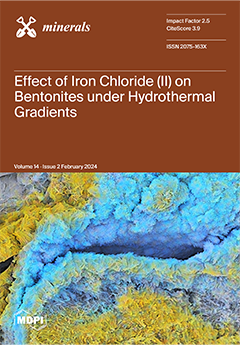To investigate the influence of organic matter conversion on the evolution of organic matter pores, fractional conversion (
TRHI) and loss of TOC (TOC
L) from the organic matter conversion of Middle Jurassic Dameigou Formation shale samples were calculated using
[...] Read more.
To investigate the influence of organic matter conversion on the evolution of organic matter pores, fractional conversion (
TRHI) and loss of TOC (TOC
L) from the organic matter conversion of Middle Jurassic Dameigou Formation shale samples were calculated using petrographic analysis. The
TRHI of organic matter varies from 0.30 to 0.88 and TOC
L content ranges from 0.62% and 4.09%. Relative to samples of Type III organic matter in shales, type II samples exhibit higher
TRHI and TOC
L values. Petrographic calculations of
TRHI reveal that the fractional conversion of different kerogens differs for the same thermal maturity level. The specific surface area (
SBET) ranges between 1.25 and 6.63 m
2/g and micropore surface area (
Smic) ranges between 4.16 and 21.27 m
2/g. Correlations between pore structure parameters and TOC
L content are higher than those between pore structure parameters and TOC content. The original TOC content decreases with increasing maturity level owing to hydrocarbon generation from organic matter conversion. The development of organic matter pores depends mainly on organic matter conversion, which is influenced by the richness, organic maceral compositions, and thermal maturity of the organic matter. The contents of kaolinite, illite, and mixed-layer illite/smectite (I/S) in the studied shales are 17.83%–37.05%, 5.36%–11.31%, and 5.27%–14.36%, respectively. Pore structure parameters (S
BET and S
mic) exhibit moderate positive correlations with illite content and I/S content, and moderate negative correlations with kaolinite content, indicating that different clay minerals have differential effects on pore structure.
Full article





